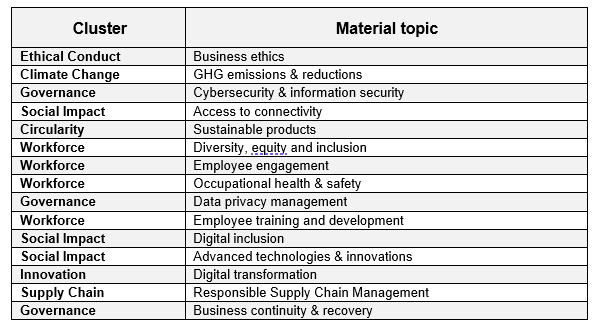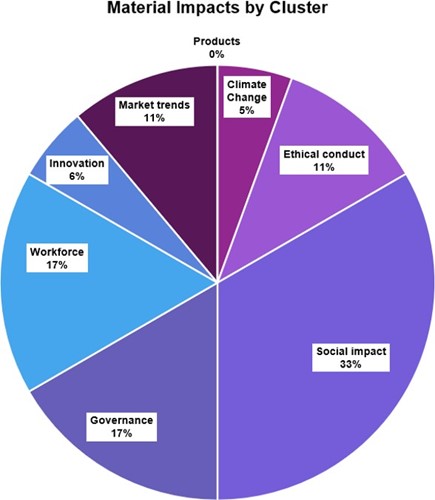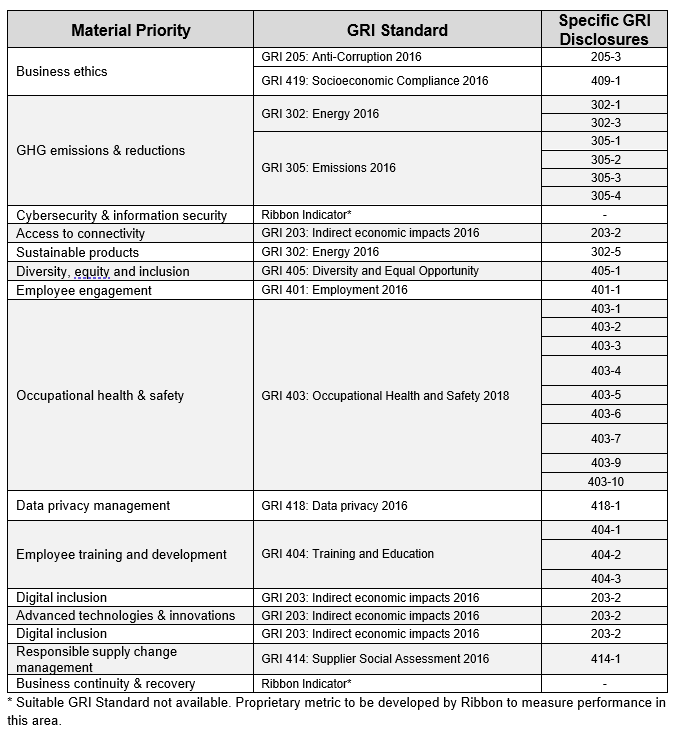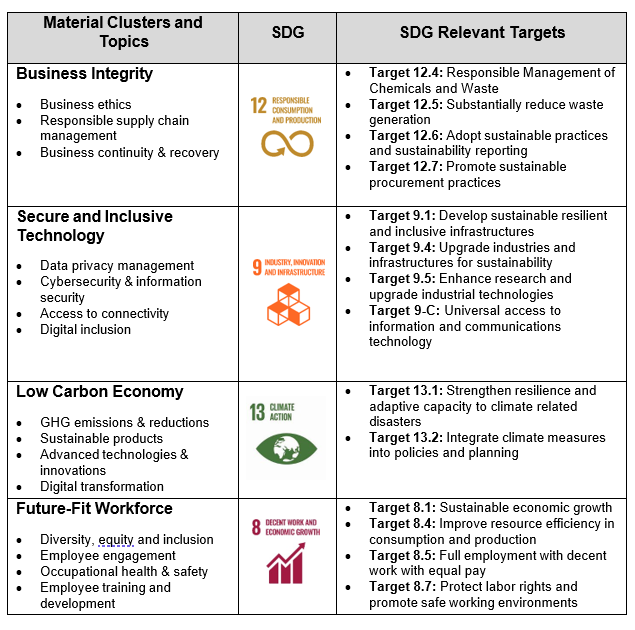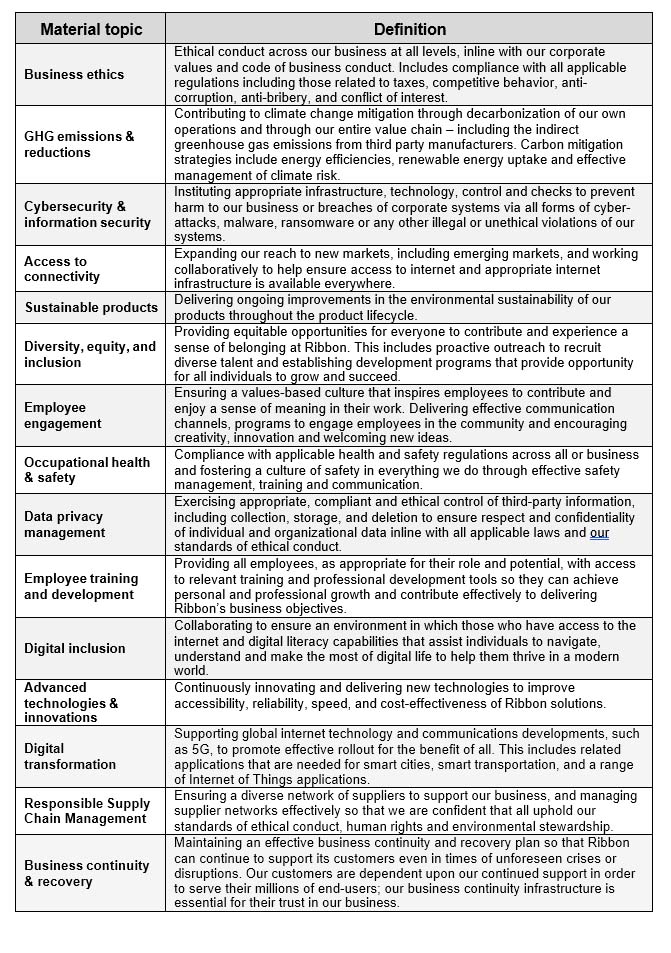Our Approach to Materiality
Overview
Material topics are those that represent the company’s most significant economic, environmental and social impacts and/or topics that substantially influence the assessments and decisions of stakeholders. It is important to define the material impacts of a business in order to focus sustainability activities on what matters most to gain the best outcomes for the business and for society, as well as to gain an early understanding of potential areas of risk and opportunity.
Stakeholders are defined as groups (or individuals) that can reasonably be expected to be significantly affected by a company’s activities, products and services, or whose actions can reasonably be expected to affect the ability of the organization to successfully implement its strategies and achieve its objectives.
Typically, a materiality assessment includes, aggregates and prioritizes a range of information from different sources, including but not limited to:
- Business strategy and capabilities
- Employee concerns and expectations
- Customer expectations
- Regulatory frameworks
- Global sustainability trends
- Voluntary sustainability disclosure standards and mandated disclosure requirements
- Investor disclosure demands
- Peer group’s materiality priorities and disclosures
- Management assessment of relative importance of the impacts on society and the environment AND the relative strength of stakeholder concerns
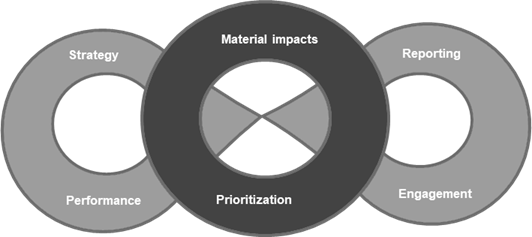
Our Approach
Ribbon is committed to following a strategic approach to sustainability and strives to continuously improve its contribution to sustainable development while minimizing areas of negative or potentially negative impact. At the same time, Ribbon believes that managing sustainability proactively can help Ribbon identify opportunities to improve its impacts on society and the environment and deliver sustainable business growth, while gaining an understanding of potential sustainability risks.
Therefore, Ribbon undertakes to define and prioritize sustainability topics in a structured process that can serve as a basis for strategy development, action planning, resource allocation, stakeholder engagement and sustainability communications. Sustainability topics defined as material are incorporated in our sustainability strategy and targets. Non material sustainability topics remain on our radar in case of future changes, and we strive to maintain performance in these areas in line with overall expectations of our stakeholders.
Material sustainability topics are generally complex, strategic topics that retain their relevance and importance over several years. We undertake to conduct a full materiality assessment every 5 years, with annual reviews and modifications in light of strongly emerging trends or changes in our business. We conducted our first full materiality assessment in 2021.
2021 Materiality Assessment
Our 2021 materiality assessment followed a structured process, involving management review and approval at each stage
Stakeholder engagement
The materiality assessment aimed to incorporate the interests, concerns and expectations of key stakeholders, defined in our stakeholder map (see ribboncommunications.com: Our Approach to Stakeholder Engagement). These stakeholder groups were defined and grouped into categories reflecting our approach to each stakeholder group as follows:
With these stakeholders in mind, we gathered additional inputs to inform our overall analysis of the relevant universe of sustainability topics for Ribbon.
Developing a universe of sustainability topics
We analyzed and aggregated the expectations of global stakeholders a broad range of standards, frameworks, trends, disclosures and direct inputs from a range of external and internal sources as follows:
Key frameworks: Globally relevant sustainability standards and frameworks (in alphabetical order):
- EcoVadis
- Global Reporting Initiative (GRI)
- ISO 26000
- ISS ESG rating elements
- NASDAQ ESG Reporting Guide
- Sustainability Accounting Standards Board (SASB) Technology Hardware and Software Standards
- UN Sustainable Development Goals
- World Economic Forum ESG Metrics
Expectations of customers, peers and suppliers: We reviewed expectations based on our regular interactions with customers and suppliers, and added analysis of material disclosures from eight large global customers, six global competitive companies and two global suppliers.
Industry trends: We scanned our universe for information about key trends and emerging sustainability topics that are connected to our current and future business as well as consulting with our own senior leaders who are active in our markets.
All these inputs enabled us to compile a list of 127 individual sustainability topics with each having the potential to be highly material in terms of our impact on society and the environment or in terms of the expectations and interests of stakeholders.
The next step was to assess these topics in detail and select those from the list that had the highest impact and the highest relevance to stakeholders.
Prioritizing sustainability topics
We took a dual approach to prioritization of the 127 topics included in our list:
Assess degree of impact: In order to assess the degree of impact of each topic, we ranked each on a scale of 0- 20, based on a consensus of management evaluation and judgement. The criteria for this assessment included the size of Ribbon’s organization and overall ability to lead/influence market change and transformation, as well as management priorities resulting from market and stakeholder demands, as perceived by Ribbon managers. Of the full list, 19 topics scored 10 or more, while 26 topics scored zero.
Assessing stakeholder interest: In order to create a prioritization of the 127 topics from a stakeholder standpoint, we scored each topic according to its relevance to each stakeholder group, based on our analysis of the frequency of appearances in different disclosures and frameworks we analysed. To reflect the differential impact of each stakeholder group on our business, each stakeholder was assigned a weight on a scale between 0.2 and 1.5, where customers were assigned the highest weighting, followed by employees and suppliers. Combining the priority scores by topics with the overall stakeholder weighting, we identified the most significant sustainability topics from a stakeholder standpoint.
Using these assessments of sustainability topics prioritized from different standpoints, we proceeded to select the most material topics.
Selecting the most material sustainability topics
We calculated an overall rating for each topic after normalizing both stakeholder assessments and impact assessments to a standard scale, allowing for comparability. We set a threshold for high materiality at 15 topics, believing that this represents a strong overall coverage of important issues reflecting different aspects of our business and meets a broad range of stakeholder needs.
This list was reviewed by our senior management and our Board of Directors. The top 15 material sustainability topics agreed by management in 2021 are:
See the Appendix in this document for full definitions of each material topic.
Aligning material topics to reporting standards
We mapped our material topic to the GRI Reporting Standards for the purposes of sustainability disclosure
* Suitable GRI Standard not available. Proprietary metric to be developed by Ribbon to measure performance in this area.
Aligning material topics to the SDGs
Appendix
v2.0 October 2021


